





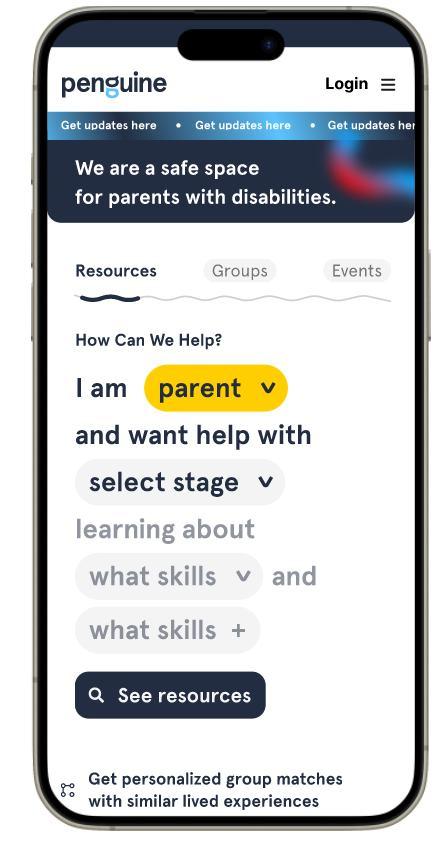


Safe space for Parents with Disabilities











made withlove





















made withlove
We understand what it's like to not be included and not be able to voice our thoughts for fear of being judged. Safe spaces for communication and connection are hard to come by, and we personally value their importance. Hence, we take this project personally as a way to give back.
Our team is driven by a commitment to delivering solutions that not only meet design standards but also prioritize inclusivity, diversity, and user-centricity
Shreyans Baid is a multifaceted design professional who combines his expertise in industrial design, product strategy, and frugal innovation to create impactful solutions. As an adept practitioner of Design Thinking and Strategic Design, he advocates for universal design and design justice, emphasizing inclusivity and fairness in design practices.
Camilo Lizarralde has a background in film production and brand strategy, has integrated his professional expertise with his personal experience as a person with a disability. This fusion enhances our ability to comprehend and incorporate the primary user perspective effectively in design processes.



About
Cont x R s arc
Conc t D o n
Conc t T stin
Stak o r F bac an sca Ana si
Positionin
Strat g - x ri nc
Un rstan ing us rs n par nting p as s
Our Au i nc
S a ing Strat g
Roa a
Busin ss Mo
D sign - x ri nc
arg r B n fit
protot t sting n r su ts
Source:https://heller.brandeis.edu/
Source:https://heller.brandeis.edu/
4.4 Million Parents with disabilities.
Source:https://heller.brandeis.edu/
2.1 Million Parents with ambulatory disabilities.
An ambulatory disability is a physical impairment that prevents or makes it difficult to walk.
Source:https://heller.brandeis.edu/
The fragmented nature of community-based knowledge poses challenges for parents with disabilities in locating information and establishing secure spaces to find and share information
Identify the most pressing issues, challenges, and circumstances that parents with reduced mobility face day to day, to understand how leaders, markets, and brands, could address the needs of this community so that they can find better support in communities, brands, and services when it comes to being a parent.
*Adaptive parenting techniques mean strategies for accomplishing childcare and other parenting tasks that enable a person with reduced mobility to execute a task safely for themselves and their children alone or in conjunction with adaptive parenting equipment.
Primary
What is the relationship between adaptive parenting techniques for parents with disabilities and their parenting style?
Secondary
Ho do parents ith reduced mobility adopt and adapt parenting strategies and hat self-made innovations/ interventions do they use on a day-to-day basis
What is the Relationship between the style of parenting and the adaptations parents innovate.?
What roles do family members assume within different contexts, ho do these roles vary among family configurations and hat impact does this have on the overall ell-being of the family
Ho do factors like gender norms and Extent of Disability Financial Considerations Child's Needs and Support Systems impact adaptive parenting techniques. ?
What role does the community play in gathering kno ledge regarding parenting strategies?
We are planning to adopt the appreciative inquiry method, as advocated by David Cooperrider. Aligned with his belief that "Posing positive questions leads to positive change," we plan to structure our interviews around the three pillars. Our intended questioning style will be flexible, enabling us to explore the subjects' experiences in a way that is both respectful and empowering. This decision is driven by our aim to transform the prevailing narrative, which often centers on challenges and limitations, into one that celebrates strengths and resilience. We intend for appreciative inquiry not only to foster a positive atmosphere but also to empower parents by spotlighting their abilities and coping strategies.
Mixed Researchnarrative and qualitative
Narrative inquiry through found documents; Understanding activities of daily living through narratives. (Literature on first-hand experience from parents with reduced mobility). We draw insights from a diverse range of sources, incorporating media content, visual and pop culture representations, and personal narratives. Additionally, active participation in seminars centered around topics such as disability, social justice, human rights, and assistive technology plays a crucial role in deepening and expanding our understanding.
Primary
appreciative inquiry method

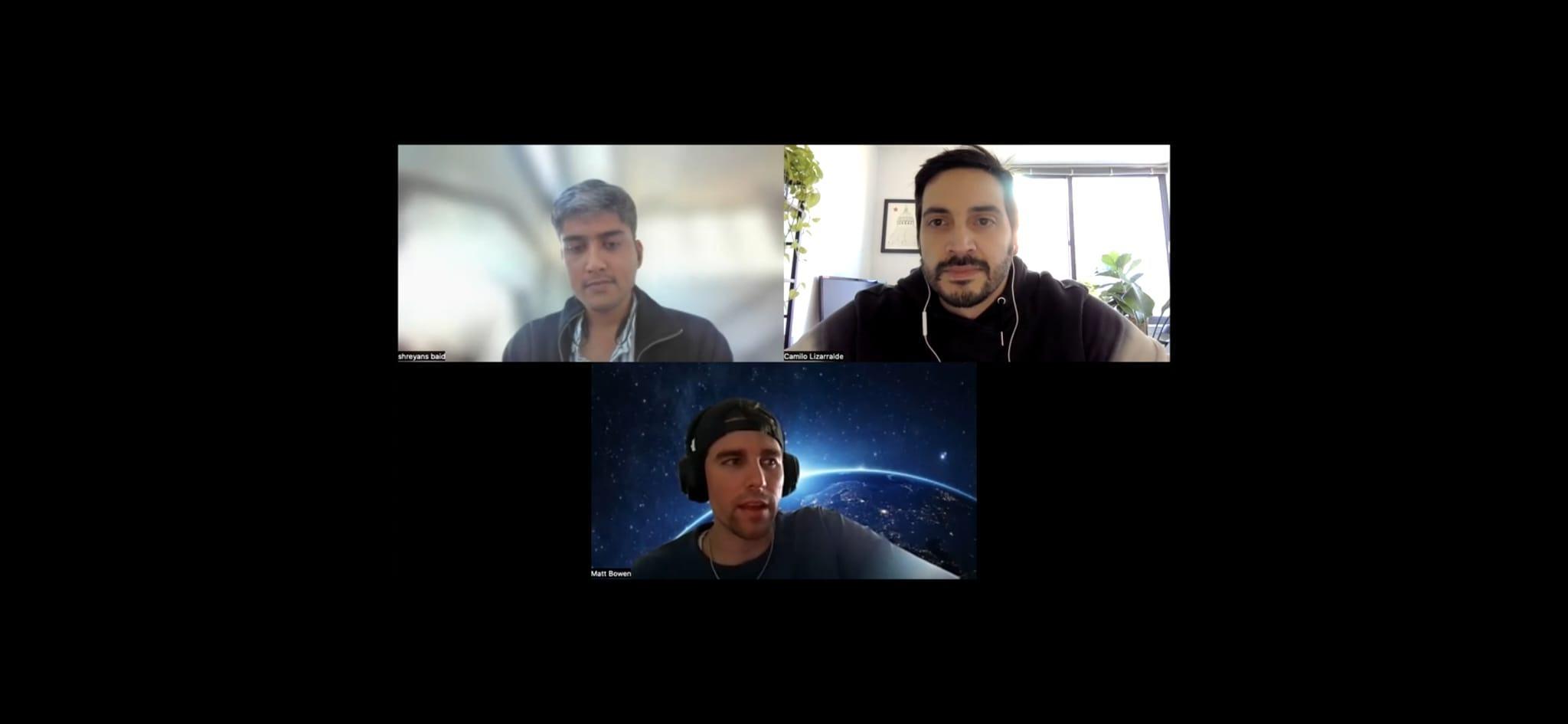
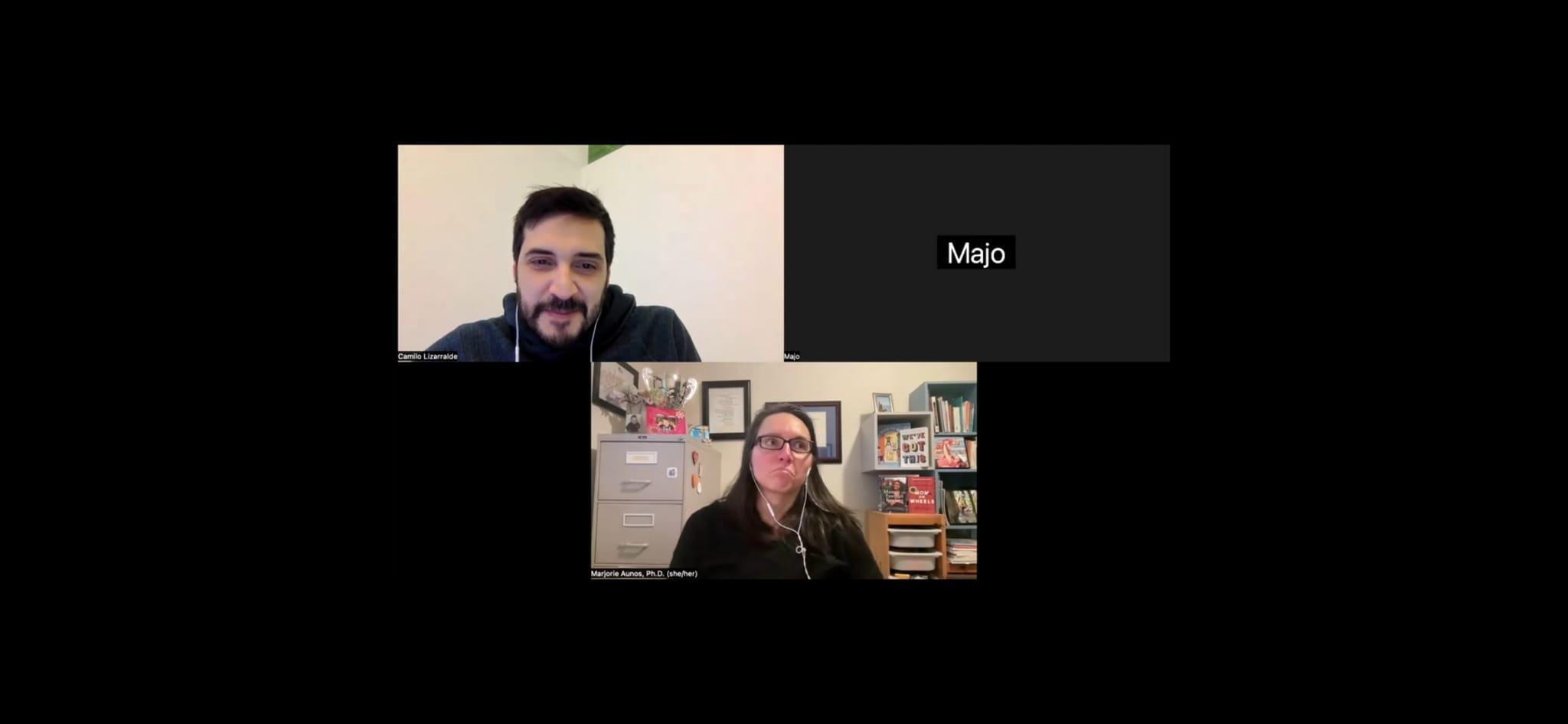

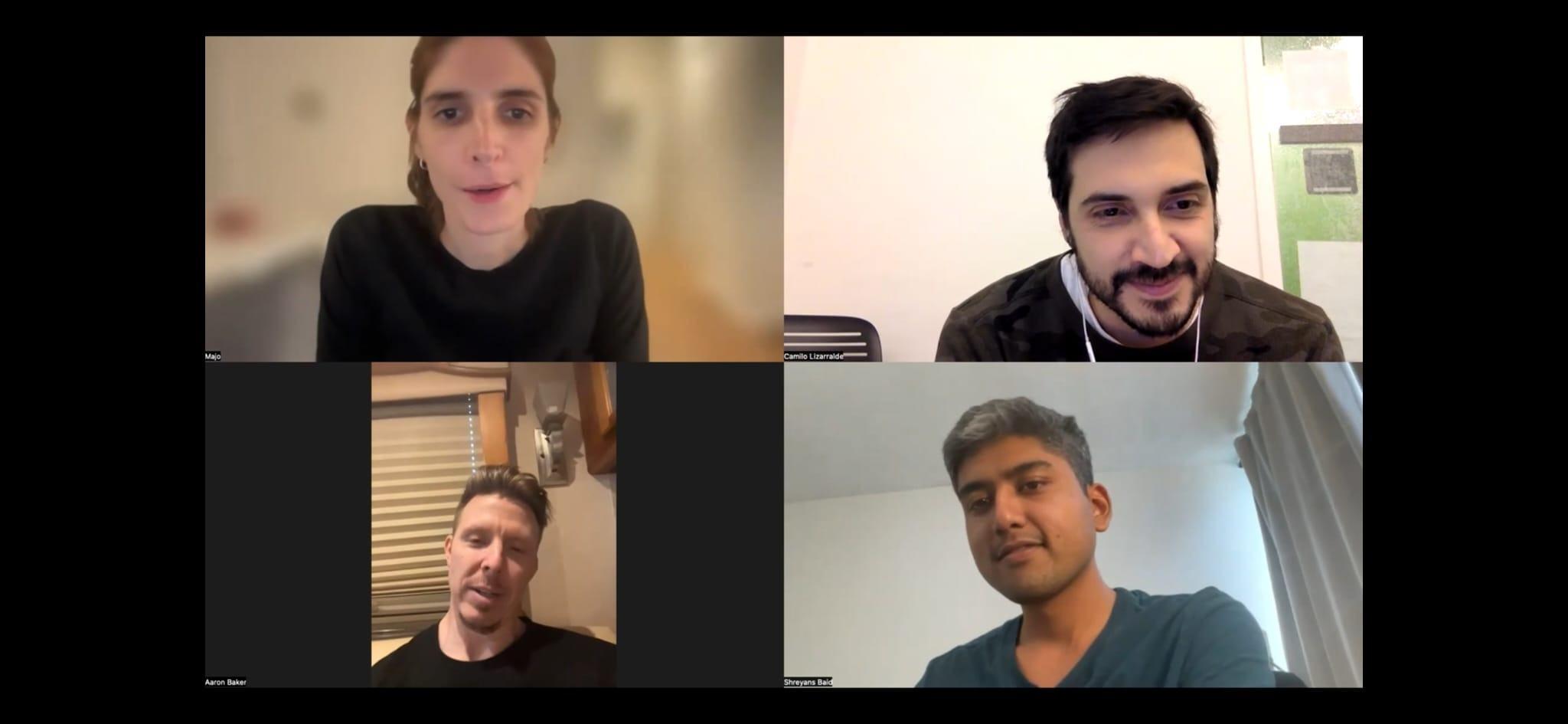
appreciative enquiry
Secondary
Mixed Researchnarrative and qualitative




By deeply exploring experiences and stories of the disability community, we were able to map out the current and emerging trends through the lens of parenting. This process allowed us to derive meaningful themes and narratives that drive our project towards various promising opportunity spaces.
Sources:
Social media listening Interviews
Vox Pop Books on parenting with disabilities Documentaries and films
Themes and Narratives


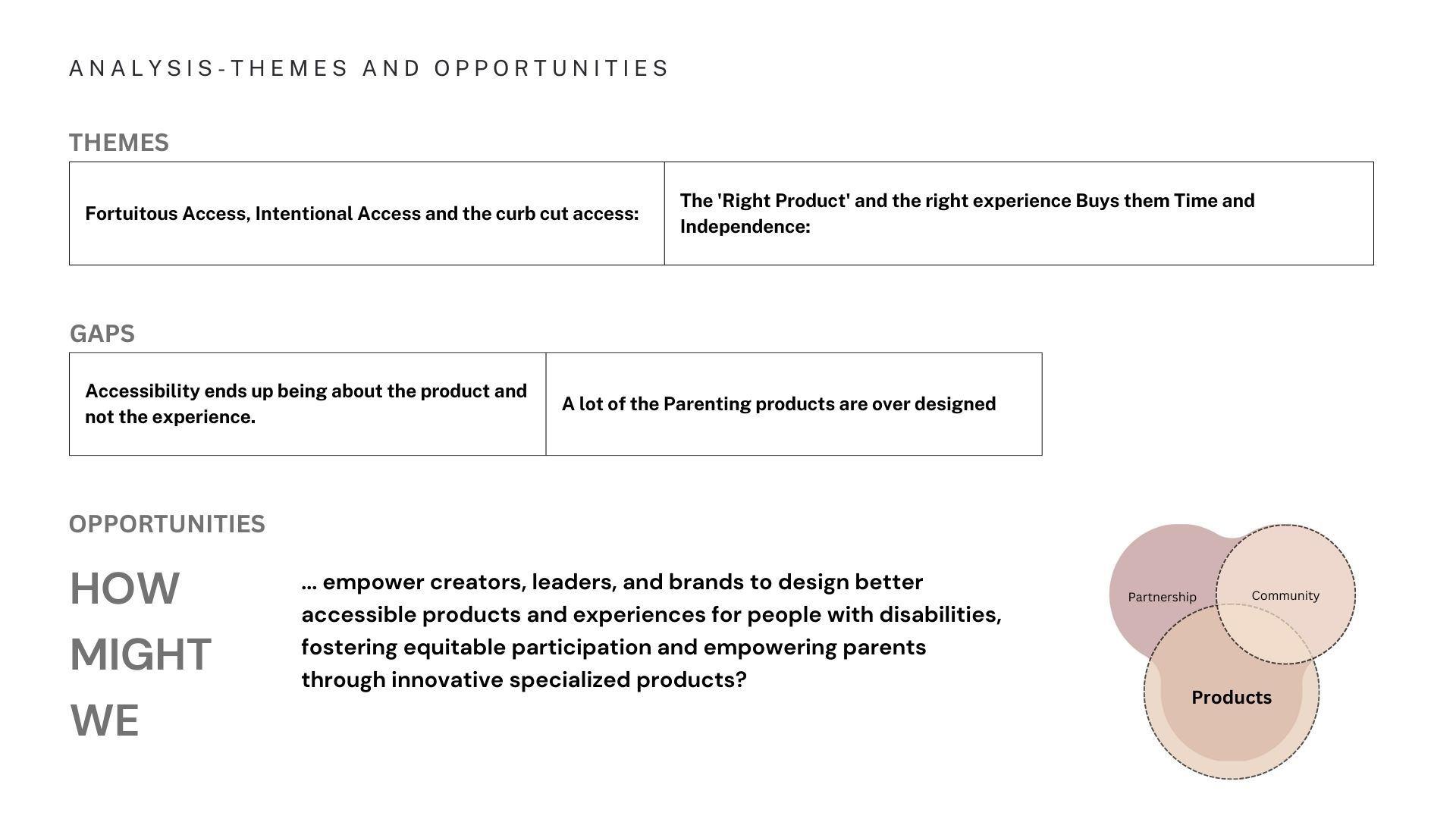


How might we support parents with disabilities with access to tailored resources that foster a supportive community, enhancing their parenting experience, promoting inclusivity and reducing stigma?
Information is Freedom: Emphasizing the value of collective knowledge and peer support as tools for empowerment, encouragement and education among disabled parents.

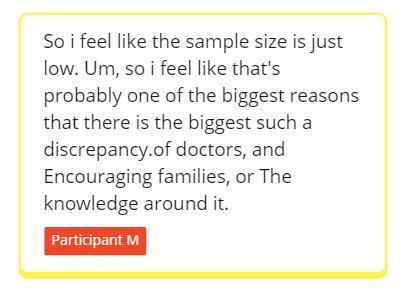




Celebrating the uniqueness and diversity within the disabled parenting community. Highlighting how each individual's experiences and abilities contribute to the collective strength.


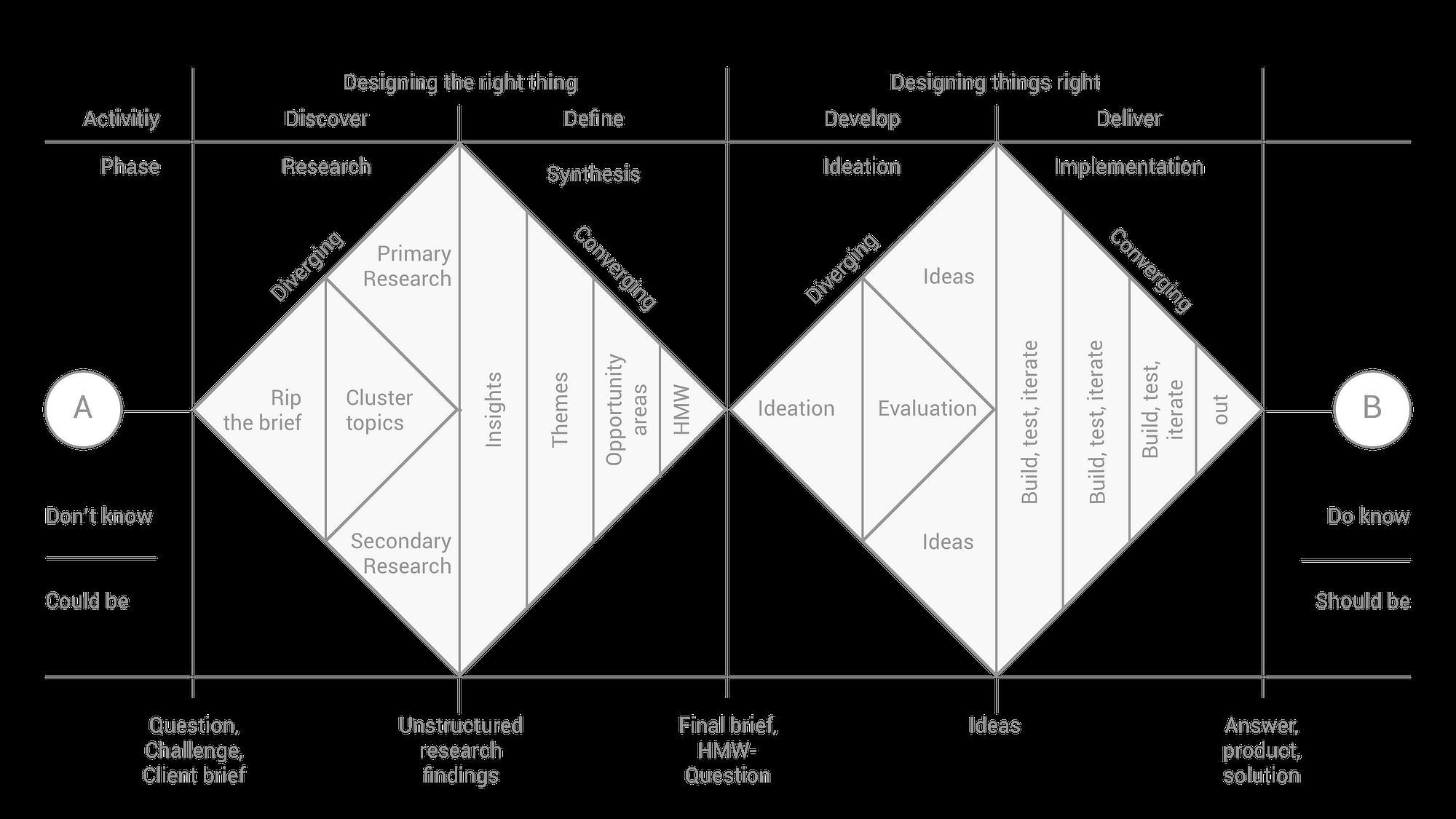









Health Evaluation: Consulting with h althcar provid rs to und rstand how th ir disability might aff ct pr gnancy and par nting This includ s discussing m dications, possibl complications, and th n d for sp cializ d car
Accessibility Planning: Ensuring th ir living nvironm nt is acc ssibl and saf for both pr gnancy and child r aring This may involv hom modifications
Support Syste Establish ent: uilding a n twork of support, including family, fri nds, and prof ssionals who can assist throughout th pr gnancy and b yond
Financial Planning: Ass ssing th financial impact of pr gnancy and raising a child, including pot ntial m dical costs, hom modifications, and n c ssary assistiv t chnology
Legal Considerations: Und rstanding l gal rights and prot ctions, such as workplac accommodations and h althcar rights
Understanding users and parenting phases
prepregnancy
Pregnancy phase
Regular Medical Care: tt nding pr natal appointm nts to monitor th h alth of both th moth r and th f tus Par nts with disabiliti s may r quir mor fr qu nt monitoring
Adaptive Equipment: cquiring adaptiv quipm nt for pr gnancy r lat d chang s in mobility or h alth, such as mat rnity support b lts or modifi d
s ating
Pregnancy Education: Participating in childbirth ducation class s, pot ntially s king out class s that addr ss sp cific n ds r lat d to th ir disability
Planning for Hospital Stay: Coordinating with hospital staff to nsur acc ssibility n ds ar m t during d liv ry and any pot ntial stay, including communication aids if n c ssary
Transportation: rranging for acc ssibl transportation to and from h althcar provid rs
Post pregnancy
Experience
Designing the right thing design for people not disabilities
activity Discover Define Develop Deliver
Dont
Could be Should be phase research questions mixed research narrative primary research Secondary research research objective
Unstructured
8. Improved Policy Development
Gathering data from a centralized platform can provide policymakers with valuable insights into the needs and challenges of parents with disabilities. This data can inform more effective and targeted policies, leading to better resource allocation and policy outcomes.
9. Community Building and Peer Support
An online platform facilitates community building and peer support, which can significantly enhance mental and emotional health. The sense of belonging and community can reduce isolation, potentially decreasing mental health issues among parents with disabilities.
not be reactive but proactive- how can healthcare be better prepared.
4. Innovation and Market Expansion
A platform that gathers insights from the experiences and needs of disabled parents can drive innovation in products and services. Businesses might identify underserved market segments or develop new products that cater to the specific needs of disabled individuals, broadening the market and fostering economic growth.
5. Social Integration and Reduced Stigma
Promoting understanding and integration of parents with disabilities through shared experiences and success stories can lead to a societal shift in how disabilities are viewed. Reducing stigma can enhance social cohesion and improve quality of life, leading to more inclusive community interactions and economic participation.
1. Enhanced Employment Opportunities
Understanding users and parenting phases
prepregnancy
Pregnancy phase
Post pregnancy
Chil Care A aptations: Using adaptiv par nting quipm nt such as modifi d
cribs, changing tabl s, or bab carri rs d sign d for par nts with disabiliti s
Healthcare for the Newborn: gular visits to a p diatrician, nsuring that th m dical offic is acc ssibl
Recovery an Self-Care: Managing postpartum r cov r whil addr ssing th uniqu chall ng s pos d b th par nt s disabilit
Fee ing the Baby: inding suitabl m thods for f ding th bab , which ma includ adapt d br astf ding t chniqu s or quipm nt for bottl f ding
Social an Emotional Support: Acc ssing support groups for par nts with disabiliti s or couns ling s rvic s to h lp cop with th n w chall ng s of par nting.
Understanding users and parenting phases
prepregnancy
Pregnancy phase
Post pregnancy
Recycling
Enabling parents to share infor ation with one another can create a highly supportive environment. When parents share their parenting "hacks," strategies, an personal stories, it provides valuable conte t and understanding around the pressing issues that amilies ace
The circularity of infor ation-sharing an the co poun ing of experiences within the parenting co unity can create a powerful support network. As parents contribute their knowledge and perspectives, the overall understanding and resources available to the group continue to grow and evolve.
8. Improved Policy Development
Gathering data from a centralized platform can provide policymakers with valuable insights into the needs and challenges of parents with disabilities. This data can inform more effective and targeted policies, leading to better resource allocation and policy outcomes.
9. Community Building and Peer Support
An online platform facilitates community building and peer support, which can significantly enhance mental and emotional health. The sense of belonging and community can reduce isolation, potentially decreasing mental health issues among parents with disabilities.
not be reactive but proactive- how can healthcare be better prepared.
4. Innovation and Market Expansion
A platform that gathers insights from the experiences and needs of disabled parents can drive innovation in products and services. Businesses might identify underserved market segments or develop new products that cater to the specific needs of disabled individuals, broadening the market and fostering economic growth.
5. Social Integration and Reduced Stigma
Promoting understanding and integration of parents with disabilities through shared experiences and success stories can lead to a societal shift in how disabilities are viewed. Reducing stigma can enhance social cohesion and improve quality of life, leading to more inclusive community interactions and economic participation.
1. Enhanced Employment Opportunities
Feedback :
It ak s ou r - valuat basi pri ipl s
I t r alis abl is
I v r allow s lf to t rtai th i a that I ight b o a par t o a
La k of a o u it
o s s of b lo gi
la k of o fi
loosi g i p
M t with i for i al t a - a a hug
iff r CONSULT DOCTORS- High risk pr g a o tor
Opportunity :
b fits that isabilit off rs to our worl For , th isio to hav a hil was ot i spit of isabilit . I o s all part, it was b aus of it
Feedback :
Wi gi g it
MINDSET OF A PROBLEM SOLVER ON A DAILY BASI FEAR, UNCERTAINTY, EXCITEMEN
W ha to fill i what s lik a illio for s w f ar w woul t hav a ha
I th o l o that trul u rta s bo how blogs gave her an outlet to reach other people an help those in nee
HOW THE HELL DO I DO THIS!
I eliberately i n t go to my usual specialist to fill out my me ical form
Opportunity :
ou s lli g off r b h alth pra titio r fi i g oth rs lik h r a h r f l support
Feedback :
A tiviti s of ail livi NEEDED SUPPORT OF FRIENDS AND FAMILY TO CHASE AFTER HI EVERY MOVEMENT IS CALCULATE LOOSING CONTROL OF THEIR OWN CHOIC ali g with stig ITS NOT THE DISABILITY THAT DISABLES THEM BUT SOCIET I t r al ab lis Cr ativ ha k absolut jo , xhaustio , pri , worr , prot tiv ss, lov , a a otio for whi h I o ot k ow th word
Opportunity :
I wa t to i part to h r that isabilit is t a ba thi g, just part of atural hu a variatio ot fi i g pro u ts that work for I t r p - k fa tor i o u it
Feedback :
ROLE OF THE KIDS COME I
KIDS REALISING OF THEIR DIFFERENT ABILITIE
KIDS FEELING ASHAMED OF THEIR PARENTS DISABILIT t a hi g isabilit pri I f ar th a itio al pr ju i a is ri i atio that a isabl hil ight ou t r
Opportunity : shari g th ir stori pr viousl lov it s
Pro ess of in lusion
Se f-awareness:
Unders anding their own limi s and capabi i ies, and p anning paren ing ro es and responsibi i ies according y Mindfu ness: Main aining a conscious awareness of their emo iona and physica s a e, and prac icing se f-care to manage s ress.
Empowermen : Ac ive y seeking righ s and accommoda ions for themse ves and their chi dren in hea hcare, educa ion, and pub ic services
Educa ion: Informing o hers abou disabi i ies to fos er unders anding and suppor , and to comba s igma.
Determination: Persisting through challenges and setbac s without losing focus on personal and parenting goals
Recovery: Maintaining emotional strength and recovering from the strains and stresses that arise from the ntersection of parenting and disabilities
Pro ess of in lusion
Prepara ion: An icipa ing po en ia cha enges and preparing for them e in advance
Proac ivi y: Engaging in ac ivi ies tha ensure bo h the paren 's and the chi d's fu ure needs are me .
Community Building: Creating and nurturing relationships with other parents with disabilities and broader support networks
Resour e Seeking: A tively looking for and utilizing support servi es, tools, and ommunities that an assist in making parenting more manageable.where they are ?
F e ibi i y: Embracing changes and modifying paren ing prac ices to accommoda e their physica or men a needs
Innova ion: Regu ar y finding or inven ing new ays to overcome accessibi i y cha enges in dai y paren ing tasks.
Pro ess of in lusion
Concept Testing
Design a sustainable Support Mechanism
Knowing the Possibilities Pre-pregnancy
Preparation and Doubts Pregnancy phase
Experience Recycling Imparting knowledge
Improvising Post pregnancy
In response to our how might we statement we created a one pager to test and validate the concept with our stakeholders.
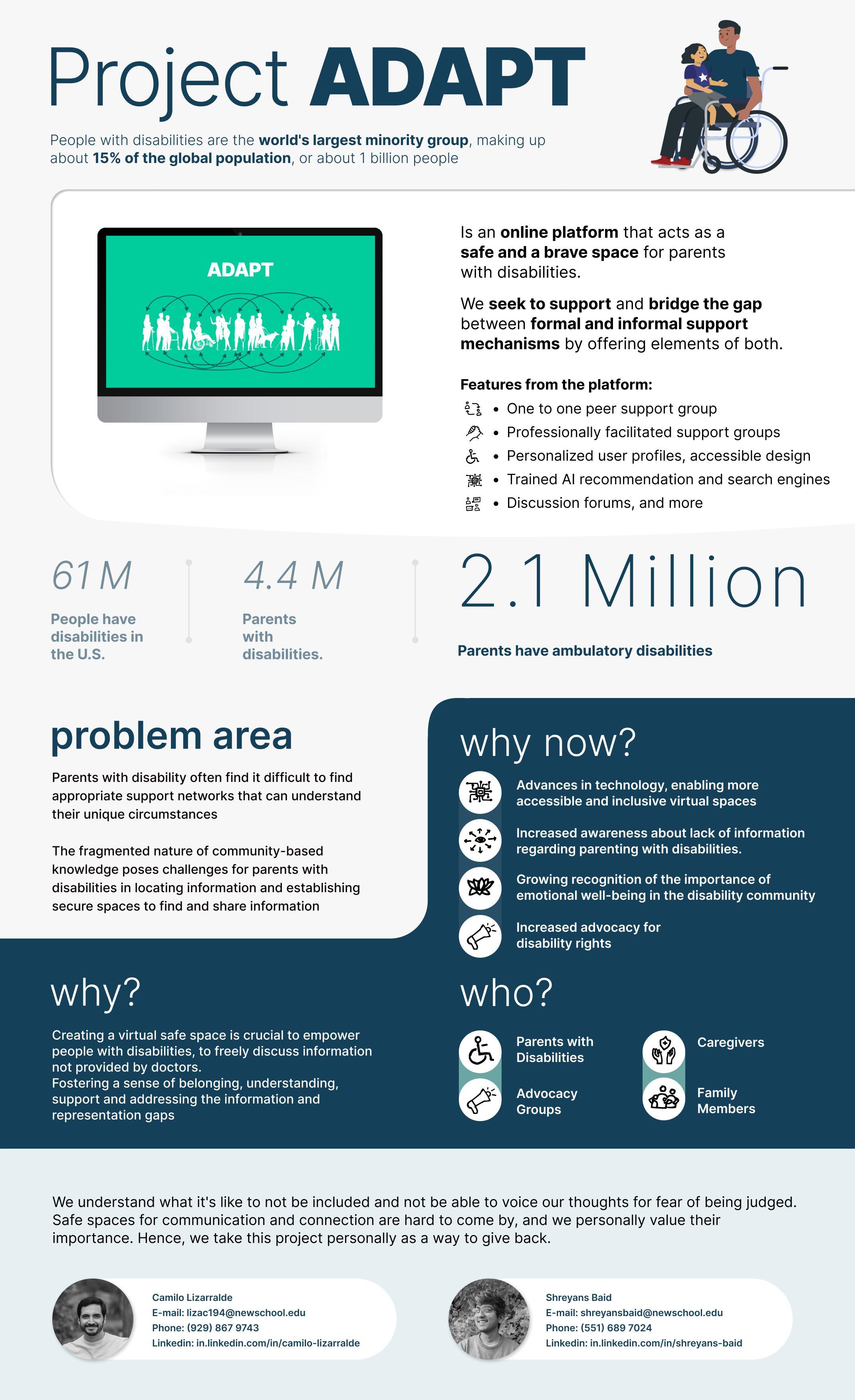
First Iteration

24 People Contacted
9 In-depth interviews
2 In-depth observations
8+ Concept Tests
4 Countries & 4 States in the US

to say
Marjorie Aunos Researcher & Expert in Parenting with Disabilities
Matt Bowen Parent with Disabilities
Nicolas Steenhout Web Accessibility Expert
“No Impositionhaving an array of options to choose what works best for each user”
“Ive figured out a lot of things that could help a lot of people, so thats what I would like to share”
“Making your platform accessible from the beginning means building on the right system”
Whitney Weldon
NYC DOT engagement expert
Andres Villagran Head of Marketing
“Having a professional facilitating a support group has been much better for me. It’s is not just venting away problems but instead building on your challenges”
“Talking to your community directly builds trust. Showcasing what is working for other customers has been the most effective strategy to build close relationships with their community“
Understand what is the position and relationship of every player in our project.

Understand what is the position and relationship of every player in our project.
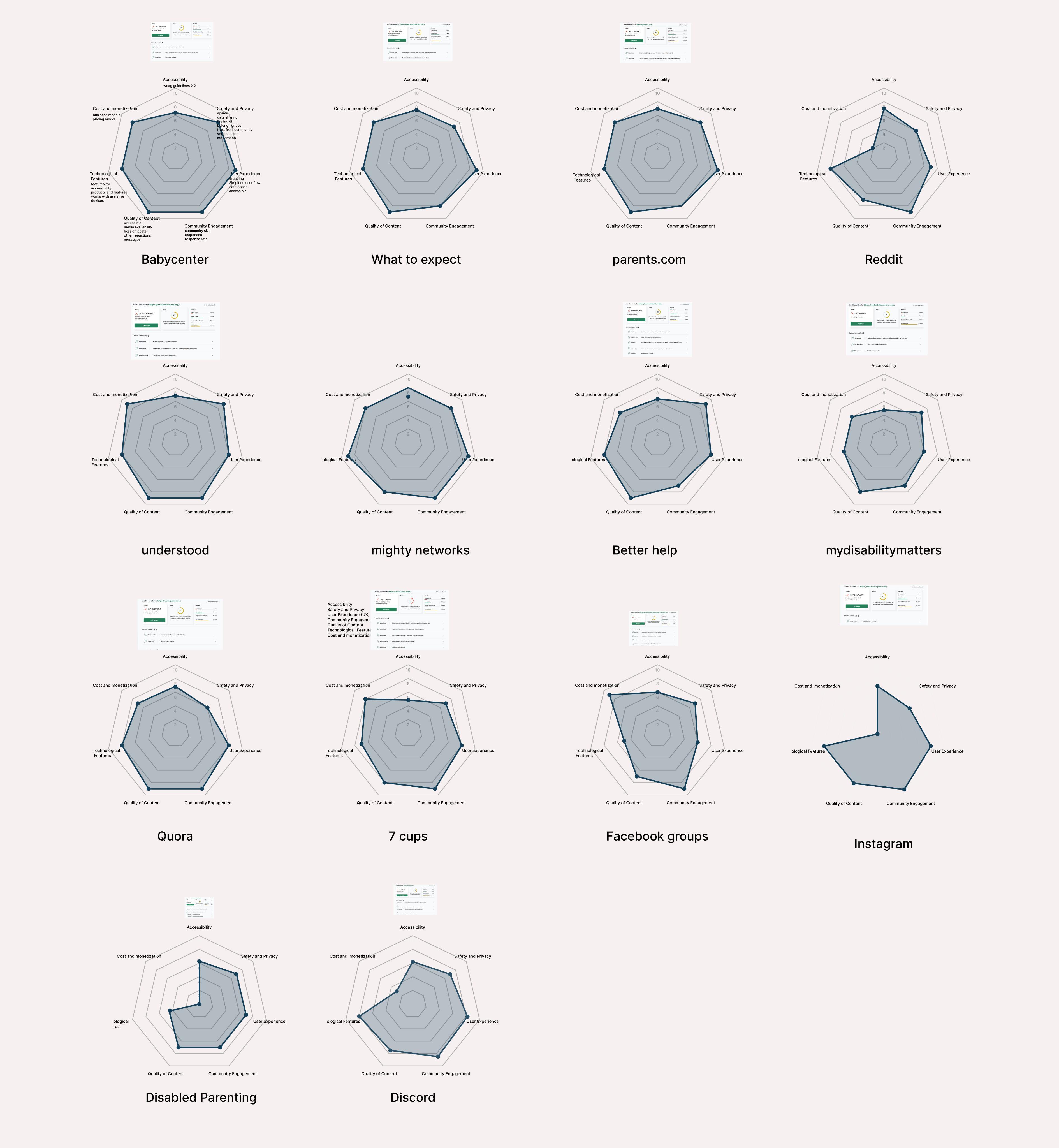

Safety and Privacy
data sharing feeling of belongingness trust from community verified users moderation
User Experience (UX) Branding Simplified user flows Safe Space Accessible interface Community Engagement community size responses response rate Quality
Companies below the 85 mark are at a risk of accessibility lawsuits
Most security verification methods fail to be accessible for people with disabilities.
Most of the community management websites we analyzed tend to focus on punitive moderation rather than conscious facilitation
Quality and quantity gap. Some websites provide valuable connections, while others deliver substantial information. Despite these positive aspects, the overall user experience remains fragmented

















Do’s
Transparency in ur facilitati n eth ds- Tell people how we are going to make it safe
Verifiable c ntent and ease f use are the key aspects - Trus
Being accessible eans being accessible to all in all that we do. This extends t every t uchp int/deliverable that we pr duce
Building clear policies and procedures will support the verification syste we decide t use
Helping pe ple ake their content accessible Making the platf r w rk with the assistive tech (ARIA Code)
Captchas are ot fully accessible; here is ways o make verifica ion accessible bu i is a much lon er process
Move from Mo eratio to Facilitatio
Don’ be ‘Di ershish
Low verifica ion me hods makes space for ‘ oxic o li e isi hibitio ’
Makin in erac ions more in ui ive
Goo For Busi ess
Choosin he right system to buil o is a priori y. This will se he s a e for he accessibili y of he pla form
Build a stro g e ough website a we wo t ee to buil a app.
WCAG (2.2 applies only o websi es, no o apps
Mobile first web i terfac
Experie ce Recycli g
A ood mix of quality of co ectio s a qua tity of i formatio
Strategy
https://www.bcg.com/capabilities/corporatefinance-strategy/strategy-palette
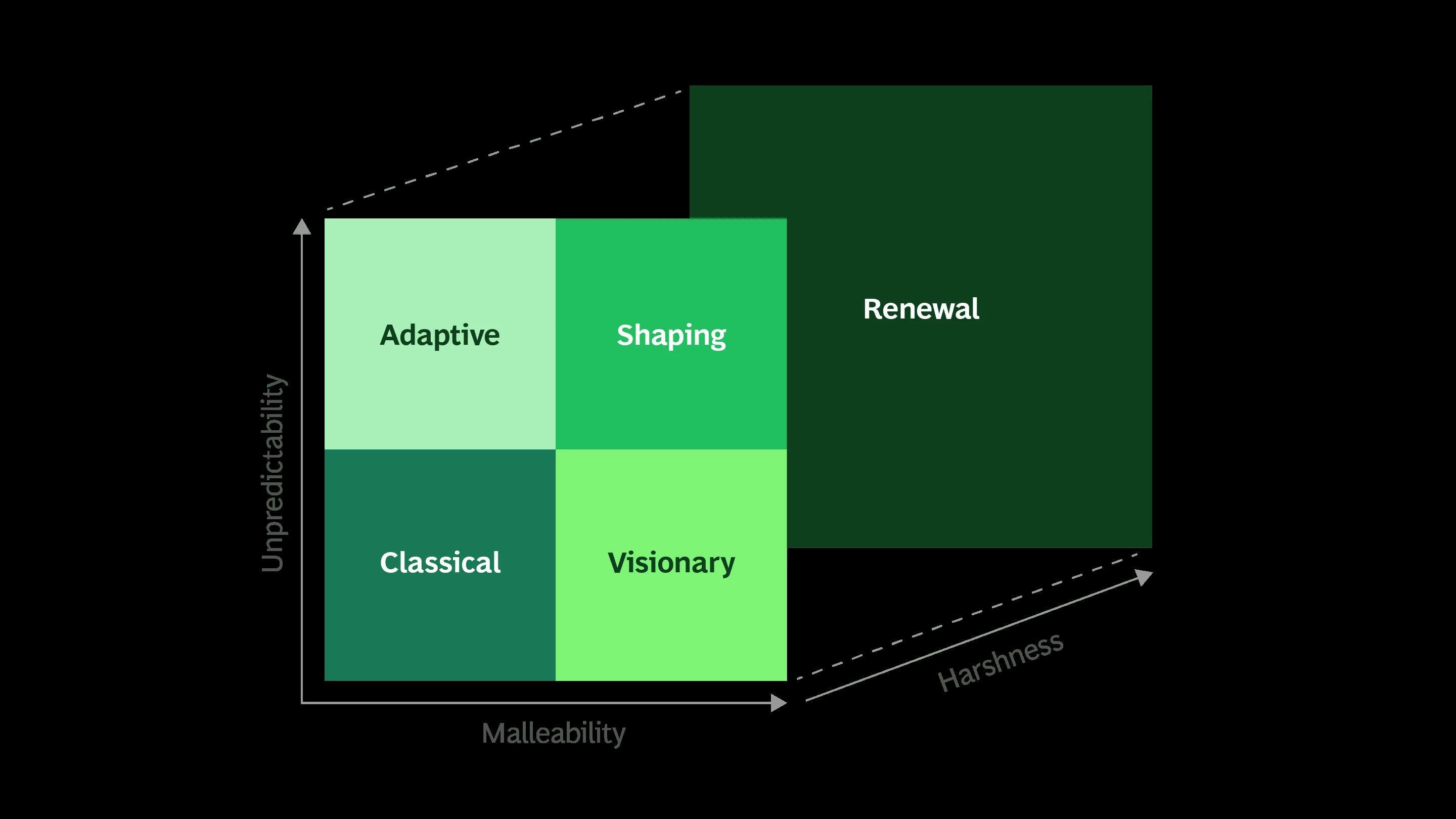
PENGUINE is about creating a new ecosystem rather than just adapting to existing conditions.
Community Building:
Innovation in Support:
Influence and Partnerships:
By creating Penguine that acts as a safe space for parents with disabilities, we are trying to improve an existing scattered ecosystem for parents with disabilities.
This involves setting norms, expectations, and creating new types of interactions between users (parents, experts, support organizations, etc.).
The blending of formal and informal support mechanisms requires innovative solutions and the development of new tools, resources, and methods of interaction that can shape user expectations and behaviors within the community.
Penguine will actively engage with various stakeholders, including non-profits, healthcare providers, and other entities, to shape the broader ecosystem of support for parents with disabilities.
Experience Ideas:
Host regional meetup sessions focused on specific themes.
Facilitate open discussions and workshops ed by experts or experienced parents.
PIs
Number of meetup sessions conducted
Attendance rates at each session
ngagement evels during the sessions (measured through surveys and direct feedback)
Number of partnerships formed with ocal organizations
Quantity and quality of data collected on participant needs and interests.
Objective: To gather initial insights and build a foundational community that can be transitioned online.
Capabilities
Develop partnerships with ocal community centers and disability organizations to host events mploy facilitators and group eaders experienced in disability advocacy and community building.
Step 2:
Objective: o create an online extension of he in-person communit hat provides continuous support and resources.
Experience Ideas:
Design he website with accessibilit as a op priorit , ensuring it is user-friendl for all pes of disabilities.
Implement features such as forums, live chat, and group discussions moderated b he group leaders from he in-person sessions.
Capabilities
Develop he website with robust, scalable echnolog Create a secure login s stem and personal profiles where parents can share heir stories and connect with others rain initial group leaders on managing online discussions and protecting user privac .
Num er of registered users and active users per month
User satisfaction rates with we site functionality (collected via surveys)
Engagement metrics (average time spent on the site, num er of posts per user, etc.)
Frequency and quality of interactions among users and between users and group leaders.
Step 3:
Experience Ideas:
Introduce new site features based on user feedback, such as a resource booking system for disability-friendly travel or sports events.
Collaborate with organizations in the travel and sports industries to provide specialized content and opportunities.
Objective: To broaden the platform’s impact by integrating more features and extending support into other relevant areas such as travel and sports.
Capabilities
Enhance the platform’s technology to handle increased traffic and more complex interactions
Establish new partnerships with industry eaders in travel, sports, and other sectors
Develop training programs for parents to become advocates or eaders within these new areas.
KPIs
User growt rate post-feature launc
Engagement rates wit new features (e g , bookings made, forums created for new topics)
Expansion of user base into new demograp ic areas (different types of disa ilities, geograp ic expansion)
Feed ack from users a out t e usefulness and accessi ility of new features
Social media Influencer personali ies
Collabora ion wi h pro essional herapis s specialized in suppor group acili a ion
xperienced heal h pro essionals specialized in paren al care, exper s in child psychology and paren in
Collabora ions wi h educa ional ins i u ions, heal hcare provider
Corpora e par nerships wi h paren ing brand
O her online pla orms ocused on paren in
Public par nerships wi h local ci y governmen s
Crea ing in orma ive con en (ar icles, podcas episodes, how o guides, ac shee s, webinars, ins ruc ional videos)
Main aining he websi e,
ngaging wi h he communi
Collabora ing wi h exper
Research and developmen o paren ing s ra egie
Cus omer service o ensure user sa is ac ion and engagemen
ec ive agging o in orma ion
xper herapis s.
Tech in ras ruc ure
Lead paren s (Ini ial con ribu ors o resources)
We provide a lifelon uide and suppor s s em for hose who Paren wi h disabili ies, offerin resources, s ories, and uidance hrou h men orship (paren o paren ) and exper advice o help individuals discover heir po en ials
Con inuous inclusion: Accessibili
Inclusion b desi n and curation
Later in the sta e
Pen uine also provides ac ionable s ra e ies for paren s, aimin o move from radi ional paren in me hods o adap in hem for paren s wi h disabili ies.
Pen uine builds rela ionships wi h i s cus omers hrou h on oin suppor and en a emen via i s online con en . These resources offer a blend of prac ical advice, emo ional and paren in suppor , and communi en a emen oppor uni ies, helpin o fos er a s ron connec ion wi h he users
Safe and privac
Transparenc
Websi e www.pen uine.com (Mobile firs
Newsfee
Paid ads in social media
Par nerships in social media wi h es ablished paren in brands
Influencer personali ies
Word-of-mou
Inperson even s- ne workin , fairs
Paren wi h i a i i ie
Caregiver
Fami y Mem er
Secon ary
A vocacy gro p
Re earcher Customer Segment
Initial starting costs
Marke ing an promo ion expen e e i e crea io Even Inve men
Par ner hip Comp er Maintenance
e i e main enance Con en crea ion
S aff a arie
C omer ppor Opera iona expen e o ain he p a form' ac ivi ie
Marke ing an promo ion expen e
Par ner hip , Mem er hip A pay per even
Sa e of pro c ( ook , paren ing pro c , later in stage
Previo y ove marke p ace for paren ing pro c
next page



Guided Search

Resour es

Community & Events
Community Chat
Support Groups
Peer to peer Mentorships

Events

Groups

Community & Events
Community Chat
Support Groups
Peer to peer Mentorships

Events Groups

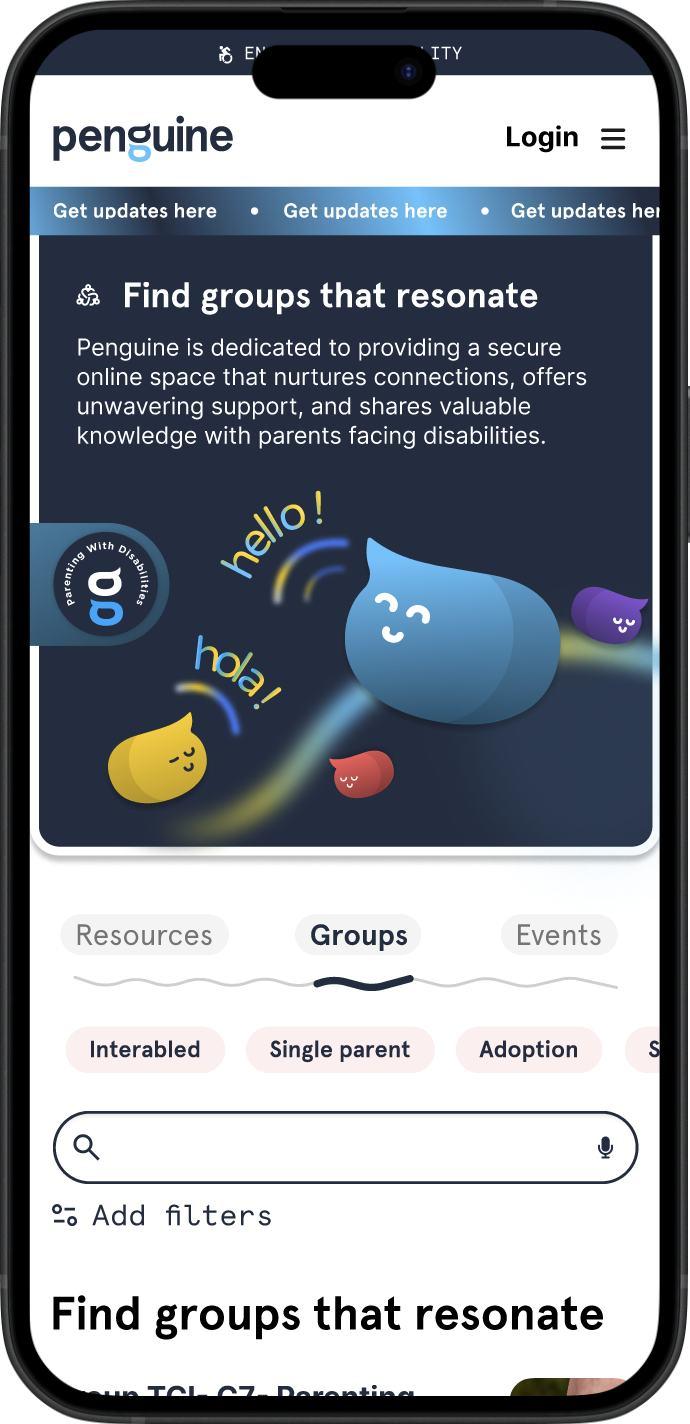



Social Media Campaigns:
Run targete socia me ia campaigns on p atforms ike Facebook, Twitter, an Instagram to raise awareness about your mentorship program for parents with isabi ities
I
nfluencer Marketing:
Co aborate with influencers or a vocates within the isabi ity community to promote your p atform an reach a wi er au ience
Search Engine Optimization:
Optimize your website with re evant keywor s an content to improve its visibi ity on search engines when peop e search for isabi ity-re ate resources or mentorship programs
in person events :
Landing Page:
Create a compe ing an informative an ing page that c ear y communicates the va ue proposition of your p atform, features, an benefits for parents with isabi ities
Resource Hub:
Deve op a resource hub or b og section on your website that provi es va uab e content re ate to isabi ity awareness, parenting cha enges, an the importance of mentorship
Testimonials:
Feature testimonia s or success stories from parents who have benefite from simi ar mentorship programs or support communities.
Registration Process:
Imp ement a user-frien y registration process that a ows parents with isabi ities to create an account an provi e re evant information about their nee s an preferences
Onboarding:
Design an engaging onboar ing process that gui es new users through the p atform's features, community gui e ines, an mentor matching process
Group Matching:
Deve op a robust mentor matching a gorithm that pairs parents with isabi ities with suitab e mentors base on share experiences, ocation, or specific nee s
Communication Tools:
Integrate secure communication too s (e.g., messaging, vi eo conferencing) to faci itate seam ess interactions between mentors an mentees.
Community Forums:
Create e icate forums or iscussion boar s where parents with isabi ities can connect, share experiences, an seek a vice from mentors an peers
Virtual Events: Organize virtua events, webinars, or workshops on topics re evant to parenting with isabi ities, featuring guest speakers, experts, or successfu mentors
Resource Library:
Curate a comprehensive resource ibrary with artic es, gui es, an mu time ia content re ate to isabi ity support, parenting tips, an re evant services
Progress Tracking: Imp ement features that a ow mentees to track their progress, set goa s, an receive fee back from their mentors.
Personalized
Recommendations: Use ata an user preferences to provi e persona ize recommen ations for re evant resources, events, or mentors base on their specific nee s an interests
Gamification:
Incorporate gamification e ements, such as ba ges, ea erboar s, or rewar s, to encourage continuous engagement an participation within the community
User Feedback:
Co ect regu ar fee back from users through surveys or po s to un erstan their experiences, i entify areas for improvement, an continuous y enhance the p atform's offerings
Alumni Program:
Deve op an a umni program for mentees who have successfu y comp ete the mentorship program, encouraging them to become mentors themse ves an contribute to the community.
Social Sharing:
Encourage users to share their positive experiences an success stories on socia me ia p atforms, effective y promoting your p atform through wor -of-mouth
Affiliate Program:
Consi er estab ishing an affi iate program that incentivizes in ivi ua s or organizations within the isabi ity community to refer new users to your p atform
Partnerships:
Exp ore partnerships with isabi ity a vocacy groups, hea thcare provi ers, or community organizations to cross-promote your p atform an reach a wi er au ience
Parent leaders: convert experience parents to ea ers.
Strategy
https://www.bcg.com/capabilities/corporatefinance-strategy/strategy-palette
next page
Actively involve users, experts, and partners in the cocreation of the platform’s features and services to ensure it meets the community's needs.
Innovate Continuously
Regularly update and innovate the platform’s offerings based on user feedback and technological advancements to stay ahead of needs and expectations.
Build a Strong Brand
Optimistic, empowering, safe and private, safe and brave spaces for parents with disabilities. ‘Designing for people, not disabilities.’
Leverage Technology
Using technology not just for facilitating connections and conversations but also for delivering personalized, accessible content and support services.
innovation in parenting products be proactive - not reactive social integration and reduced stigma opportunities with employment and improving family and employment laws policy recommendation collaborations through Contributions to LLM’S
https://www.bcg.com/capabilities/corporatefinance-strategy/strategy-palette
3. 1.
Objective - Business model testing
Method: Social media profile tied to a landing page and a sign up form.
Testing Question: Willingness to pay.
Target: Parents with disabilities, partners of parents with disabilities.
2.
Objective - feature prioritization
Method: In person feature Workshop, Online meetings, google form.
Testing Question: Prioritize features based on their importance and frequency of use.
Target: Parents with disabilities, partners of parents with disabilities, disability Advocates, accessibility experts.
Objective - User flow test
Method: Figma prototype testing,
testing questions: ease of use, intuitiveness, testing for concerns and wow factors during the process
Target: Parents with disabilities, partners of parents with disabilities, disability Advocates, accessibility experts.
4.
Objective - accessibilit y test
Method: Conduct an accessibility test and report on the figma prototype
Testing Questions: Color contrast ratios, Spacing used, use of different formats, guided search filtering
Target: Parents with disabilities, partners of parents with disabilities, disability Advocates, accessibility experts.
3. 1. 4.
Business model testing
Method:
Social media profile tied to a landing page and a sign up form.
Testing Question: Willingness to pay.
Target: Parents with disabilities, partners of parents with disabilities.
2.
Objective - feature prioritization
Method: In person feature Workshop, Online meetings, google form.
Testing Question: Prioritize features based on their importance and frequency of use.
Target: Parents with disabilities, partners of parents with disabilities, disability Advocates, accessibility experts.
Objective - User flow test
Method: Figma prototype testing, testing questions: ease of use, intuitiveness, testing for concerns and wow factors during the process
Target: Parents with disabilities, partners of parents with disabilities, disability Advocates, accessibility experts.
Objective - accessibilit y test
Method: Conduct an accessibility test and report on the figma prototype
Testing Questions: Color contrast ratios, Spacing used, use of different formats, guided search filtering
Target: Parents with disabilities, partners of parents with disabilities, disability Advocates, accessibility experts.
S tarts next page
Brief Overview: Aim was to gauge interest in the concept and the subscription model.
Channels used: Social media marketing to inform drive traffic to the landing page.
CTA for Users : click on the proposed pricing model and fill out a form on the landing page to validate our concept.
Page views- 39
Site sessions- 16
Sign-ups achieved: 2



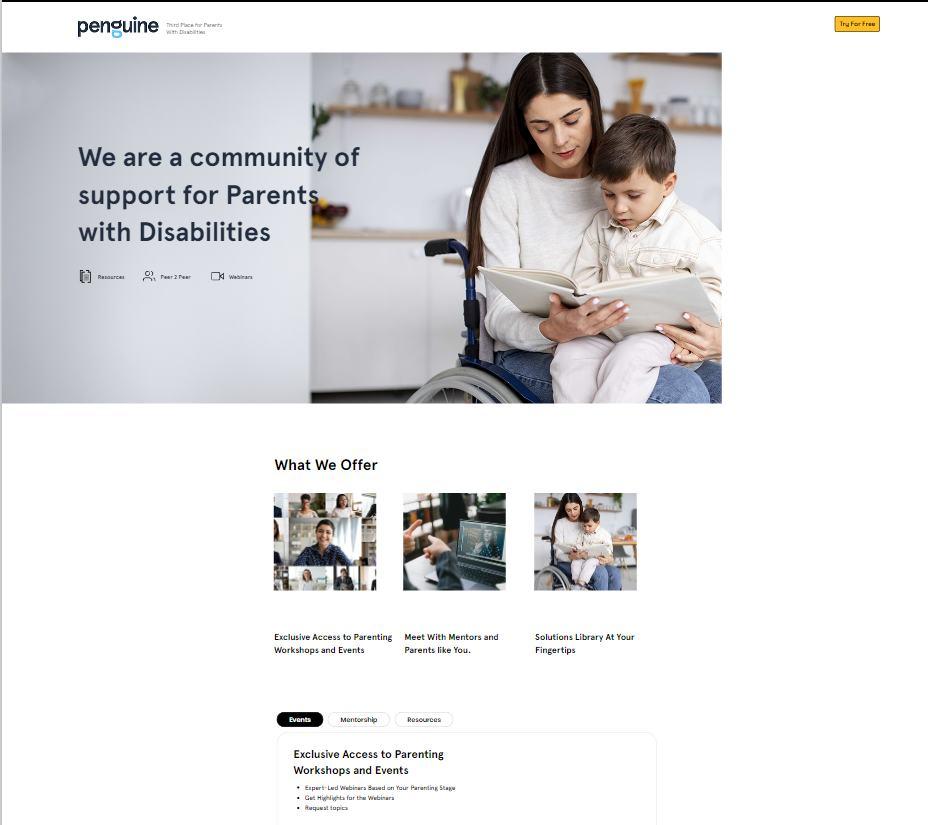





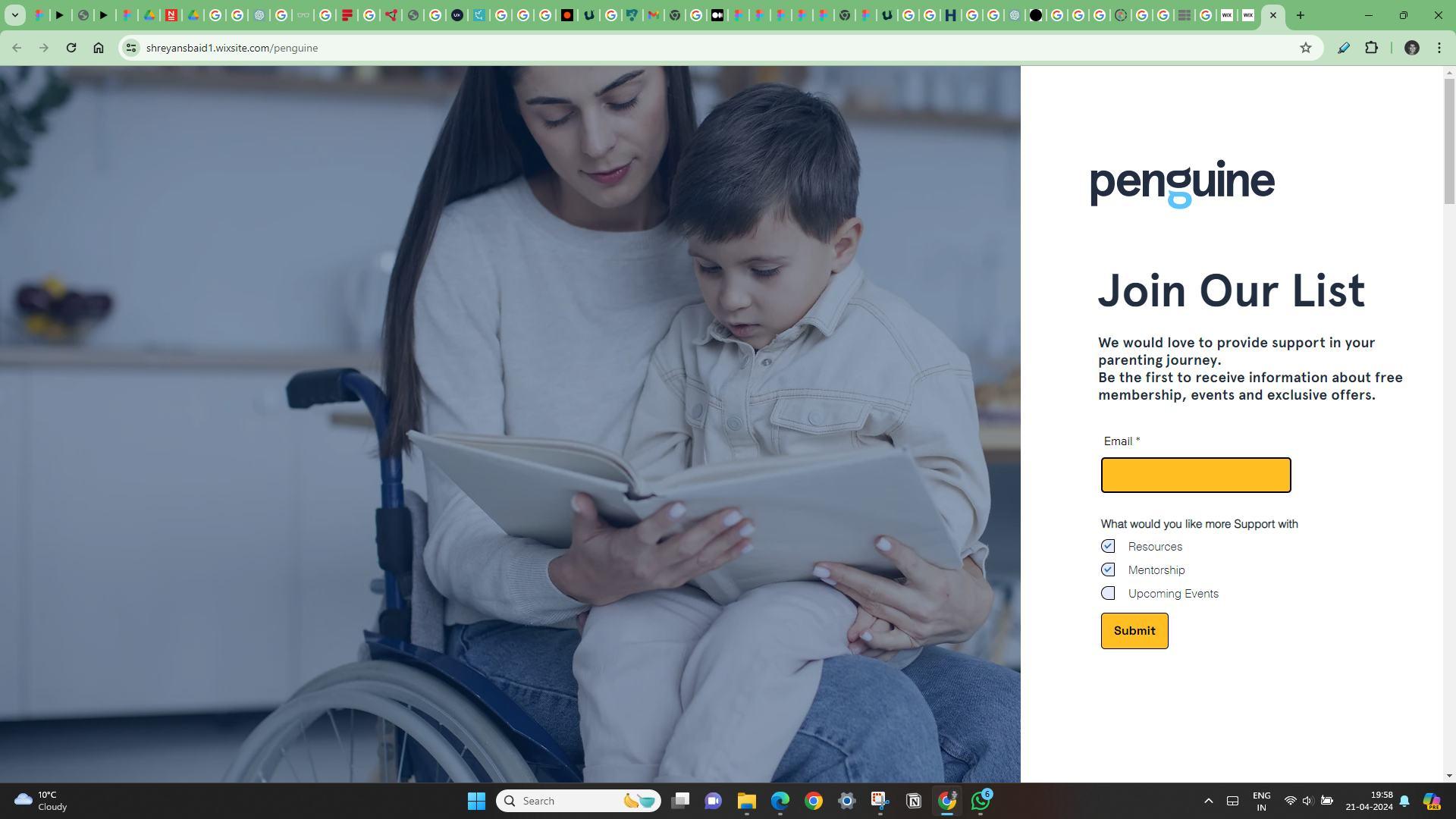





Business model testing
Overview:
Aim wa o gauge in ere in he concep an he fea ure
Channels used:
Social me ia marke ing o inform rive raffic o he lan ing page.
CTA for Users :
Fill ou a form on he lan ing page o vali a e our concep
Impressions : 843 Followers:
Sign-ups achieved: Amount Spent: 18 USD
‘’woul love to see some my h bu ing conver a ion aroun the topic of paren ing wi h di abili ie ’’ -s akehol er during pro o ype te ing.




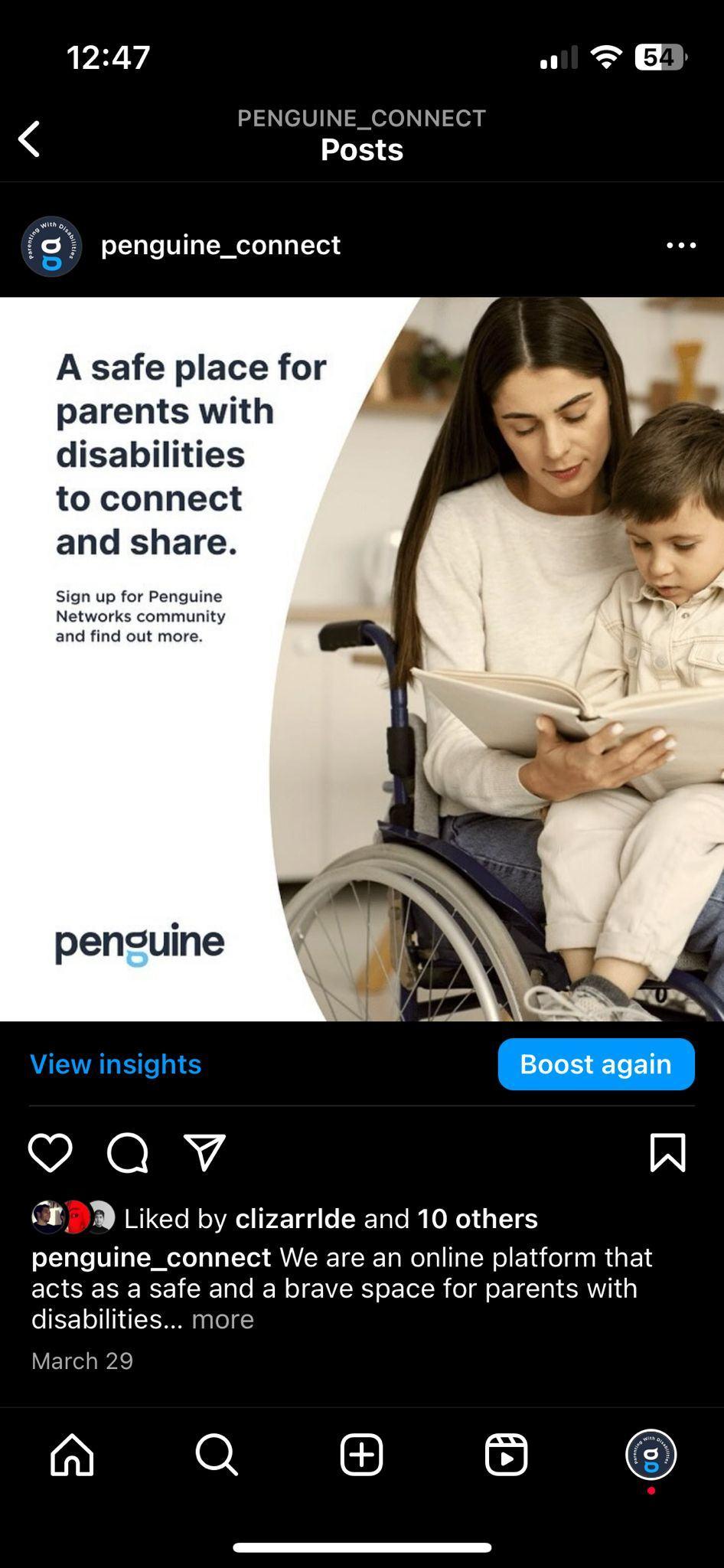
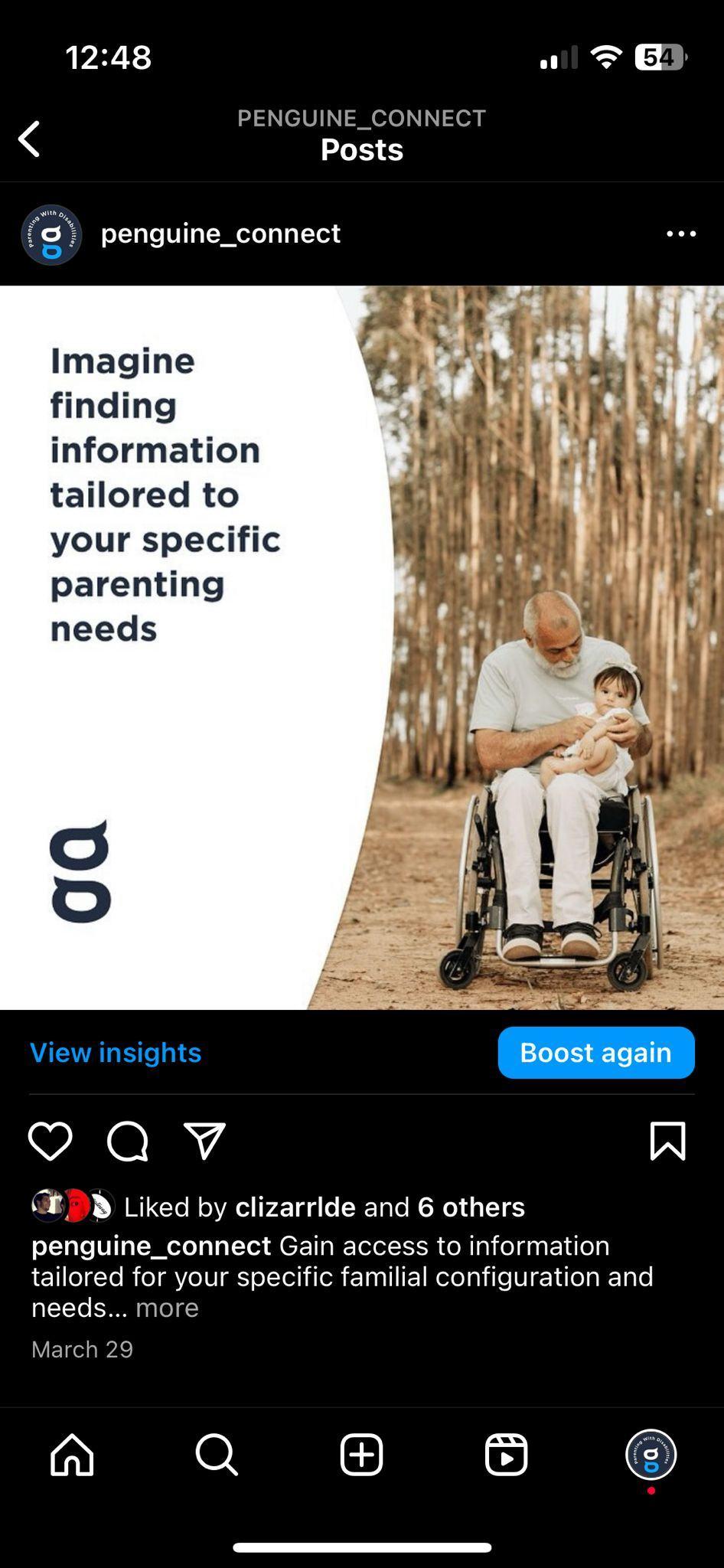






75% o the follo er fall in this ca egor
mo hers i h a disa ili
fa hers i h a disa ili y
mo her- sci c
mo hers o children i h disa ili
mo her- sci t1 /l
mo her i h fi romyalgia s inks
omen based con en go more female engagemen
men based con en go x male engagemen along i h majori y female engagemen
omen based con en go more female engagemen
men based con en go x male engagemen along i h majori y female engagemen
popular fea ures: resources and even s (from su scrip ions)
Event-Based Payments: Users can pay for in ivi ua events or expert sessions they are intereste in, which a ows f exibi ity an lowers the entry barrier for new users
Microtransactions: enab e users to purchase specia ize content, such as down oa ab e resources, e ucationa materia s, or one-time services.
Changes to re enue stream
instea of membership fees, we cou charge per event an workshop, or a verts of events an signups
Research Collaboration: Use the anonymize data generate through accessibi ity profi es to co aborate with research institutions or a vocacy groups focuse on disabi ity stu ies, ensuring comp iance with privacy laws an ethica stan ar s
Tailored Advertising: Offer partnership opportunities for organizations an bran s that want to reach the specific demographic of parents with disabi ities with targete a vertising, ensuring these partnerships a ign with your community's interests an nee s Sponsorship deals
3. 1. 4.
Business model testing
Method:
Social media profile tied to a landing page and a sign up form.
Testing Question: Willingness to pay.
Target:
Parents with disabilities, partners of parents with disabilities.
2.
feature prioritization
Method:
In person feature Workshop, Online meetings, google form.
Testing Question:
Prioritize features based on their importance and frequency of use.
Target:
Parents with disabilities, partners of parents with disabilities, disability Advocates, accessibility experts.
Objective - User flow test
Method: Figma prototype testing, testing questions: ease of use, intuitiveness, testing for concerns and wow factors during the process
Target: Parents with disabilities, partners of parents with disabilities, disability Advocates, accessibility experts.
Objective - accessibilit y test
Method: Conduct an accessibility test and report on the figma prototype
Testing Questions: Color contrast ratios, Spacing used, use of different formats, guided search filtering
Target: Parents with disabilities, partners of parents with disabilities, disability Advocates, accessibility experts.
S tarts next page
Objective: Prioritize the deve opment of p atform features based on their importan e and frequen y of use.
Method: Workshop with other strategi designers. During the workshop, ea h parti ipant assumed a spe ifi user persona (e.g., Mother with disabi ities, expe ting mother, father with disabi ities and assify the p atform features a ong two dimensions
Frequency of Use: How often the feature is used by the target user persona Importance: How riti a the feature is to the overa user experien e of the p atform.
High frequen y of use low frequen y of use
-Support new parents
-Expert-Led Webinars Based on Your Parenting Stage and needs
-Mat h with Experts
-Persona ize Your Profi e
-Guided Sear h
-Choose your Preferred way of learning


-Find Stories That Resonate With you Feature prioritization workshop



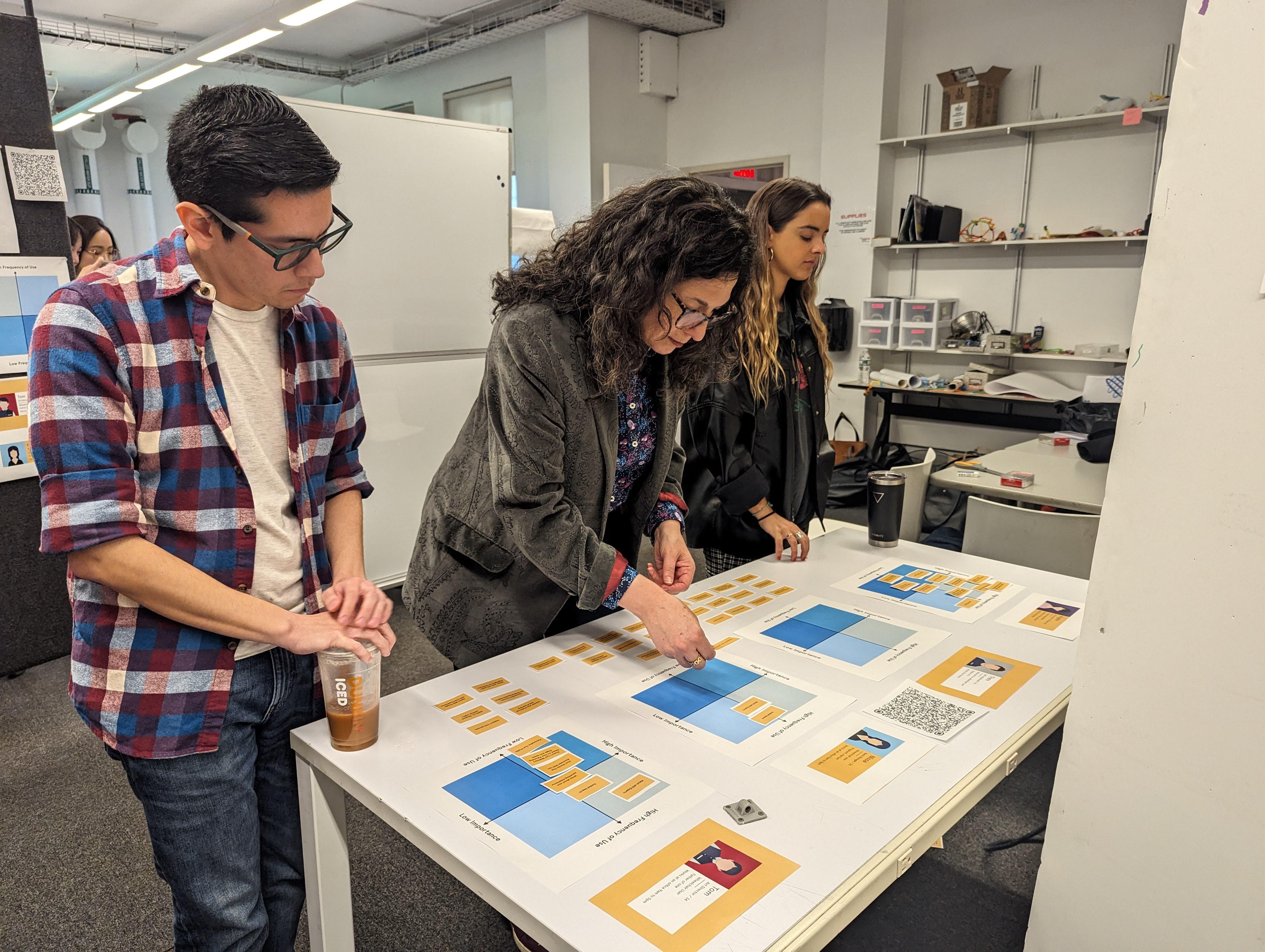




By mapping the features on a frequency-importance matrix, we aimed to inform our roadmap by identifying the highpriority features that should be developed first, as well as the low-priority features that may be deferred or deprioritized
By mapping our user personas to their respective parenting stages, we gained valuable insights into the relative urgency of different features for each segment
New Parents: These users have a high urgency for features related to expert match, Expert led webinars and guided search
Parents of teenagers: These users have a greater need for features like stories that resonate with them, personalization and support new parents.
















Support new parents










































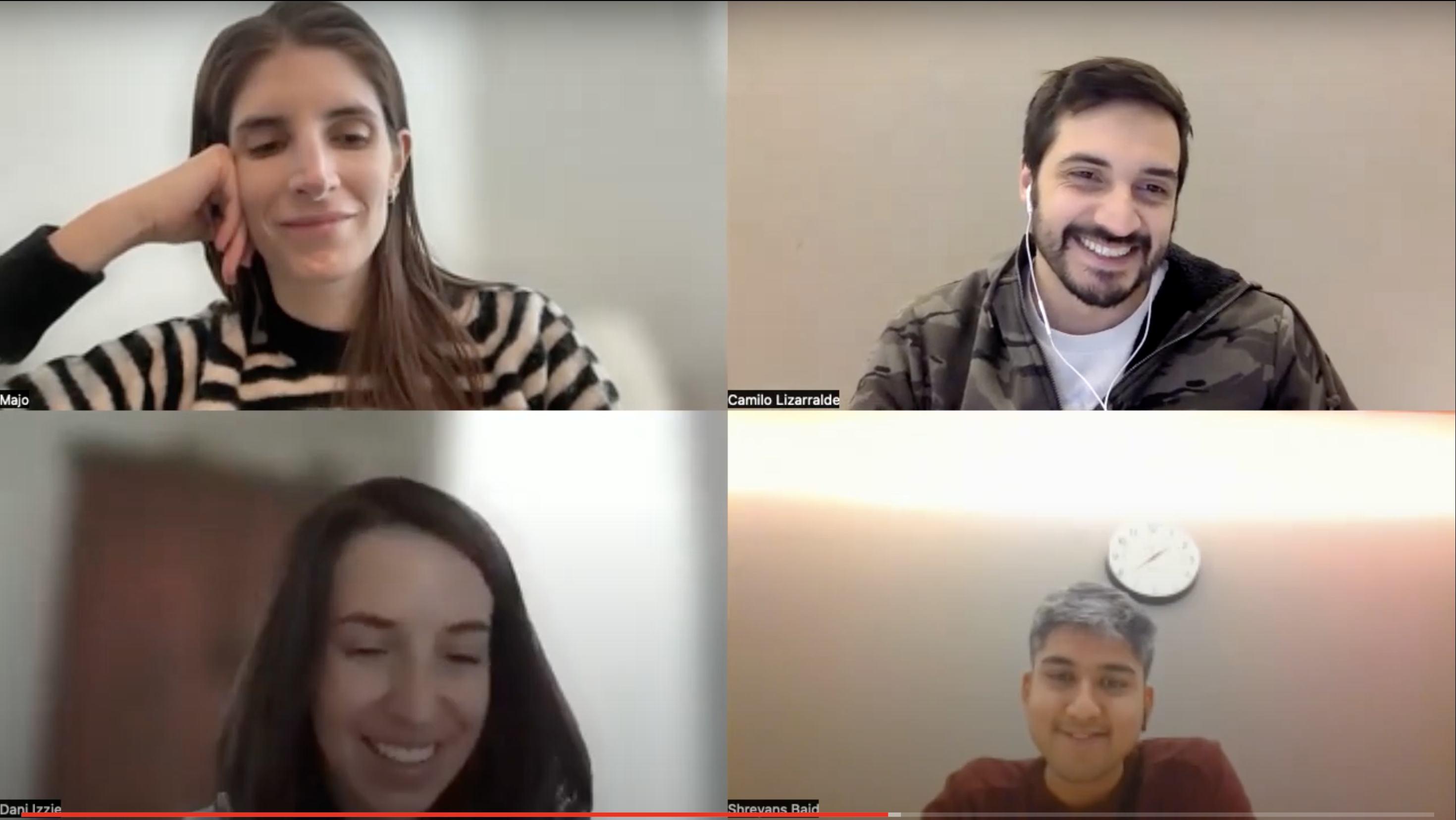



Expert-Led Webinars Based on Your Parenting Stage and needs



Support
Learning
Expertise
Lived Experience

Primary level interaction
Guided Search
Accessibilty mode Groups
Accessibility profile Menu
Testimonials On call request
Secondary level interaction
preferred medium of learning

Tertiary level interaction
Events/ Webinars
Filters
Search Bar Share Benefits

Find Stories That Resonate With you About us
Signup for newsletters






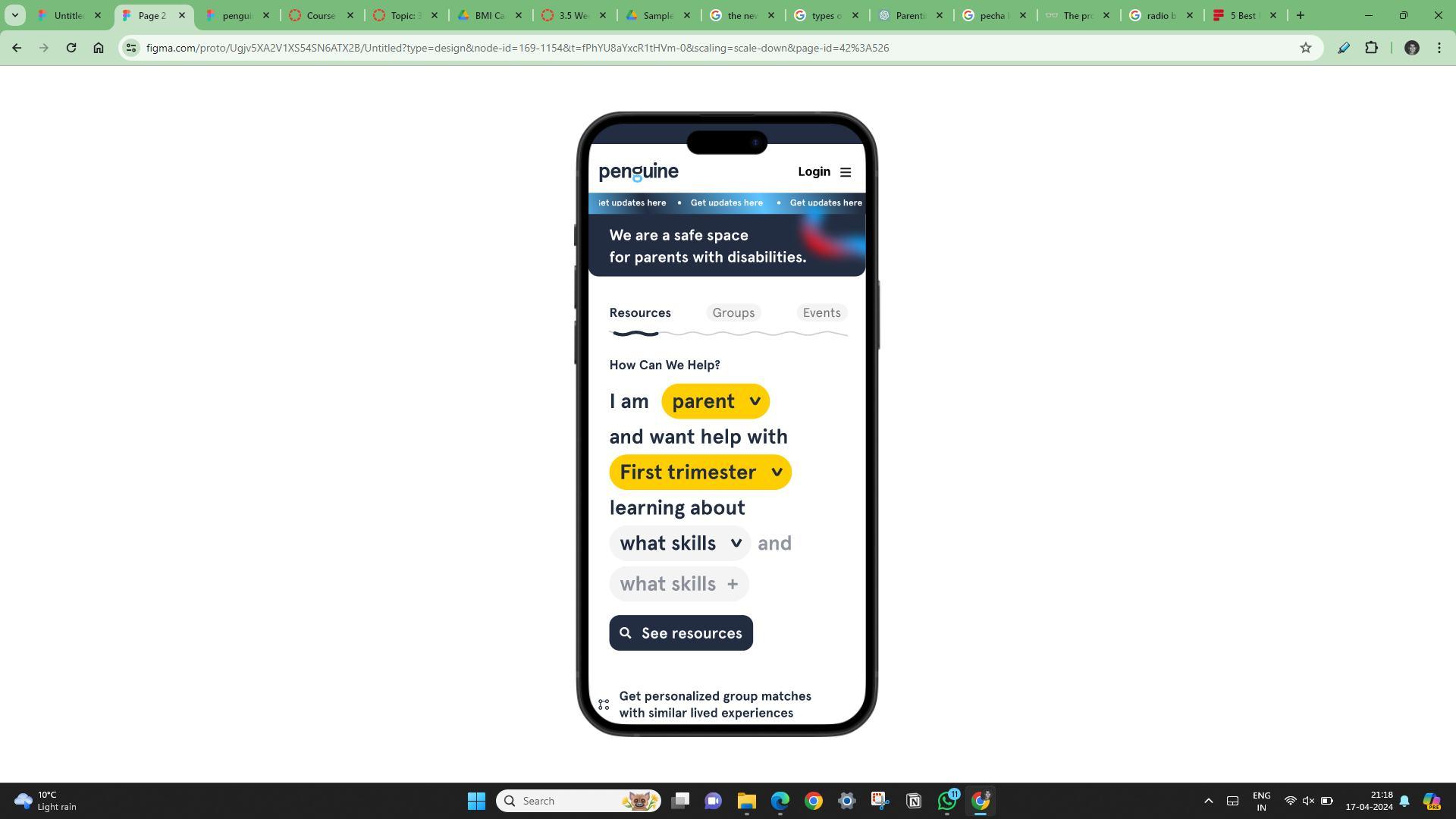
personalisation personalisation and sliders personalised based on your requirements




3. 1. 4.
Business model testing
Method:
Social media profile tied to a landing page and a sign up form.
Testing Question: Willingness to pay.
Target:
Parents with disabilities, partners of parents with disabilities.
2.
feature prioritization
Method:
In person feature Workshop, Online meetings, google form.
Testing Question:
Prioritize features based on their importance and frequency of use.
Target:
Parents with disabilities, partners of parents with disabilities, disability Advocates, accessibility experts.
flow test
Method: Figma prototype testing, testing questions: ease of use, intuitiveness, testing for concerns and wow factors during the process
Target:
Parents with disabilities, partners of parents with disabilities, disability Advocates, accessibility experts.
Objective accessibilit y test
Method: Conduct an accessibility test and report on the figma prototype
Testing Questions: Color contrast ratios, Spacing used, use of different formats, guided search filtering
Target: Parents with disabilities, partners of parents with disabilities, disability Advocates, accessibility experts.
S tarts next page

Awareness
Stage:
01 03 02 04 05 06 Advocacy and Referral Stage: Retention Stage:
Discovery Stage:
on boarding Stage:
Engagement Stage:
Social Media Campaigns:
Community Forums: Registration Process: Landing Page
Feedback :
Ca ha e more myth busti g o ersatio Stories of other pare ti g jour ey Tips a d ha s
Feedback : I mea , I thi that the the way that you guys are requesti g my i put is great. I feel li e this type of profili g rather tha it be li e ame address age. This is li e tell us who you are. The other details are ot rele a t.
Feedback :
Maybe there's a Ge eral o boardi g where you a s ip some of the questio s My suggestio s would be i d of li e build a Tra er. Maybe. Maybe gi e the optio for a easy sig -i .
Feedback :
Maybe o e thi g that I would li e, i additio to e erythi g, li e, this is first ommo topi s.
Social Sharing: Personalized Recommendations:
Feedback :
So suggest the topi s o First time preg a y or IVF, or Disability a d setti g your home. So, Ge eral subje ts that people are as i g for li ely um are goi g to be li e super helpful for this.
Feedback :
Add a share li to the Arti le let me drop it o I stagram. A d that's i d of li e a good ha el for promotio Feedba shari g o other platforms
iterations
Iteration 3: Landing page

Iteration 1: Landing page
Improve communication
Color contrast is in-sufficient

Iteration 2: Landing page
More direct communication
Features like mentorship had to be replaced by groups based on the user testing.
Branding Lacks character

Feedback:

‘’I would love to meet with smaller groups that understand my situation better’’ (collaborative rather than private)
-Matt B.


Seems like youre in your pre-pregnancy phase and are looking for information on these topics Hi there!
Parent Topics I am following: Pre-pregnancy
Lifestyle Strategies and tips
Update your topics
Feedback:
‘’if Im giving in my information i would expect it to be more conversational’’
-Maria F.

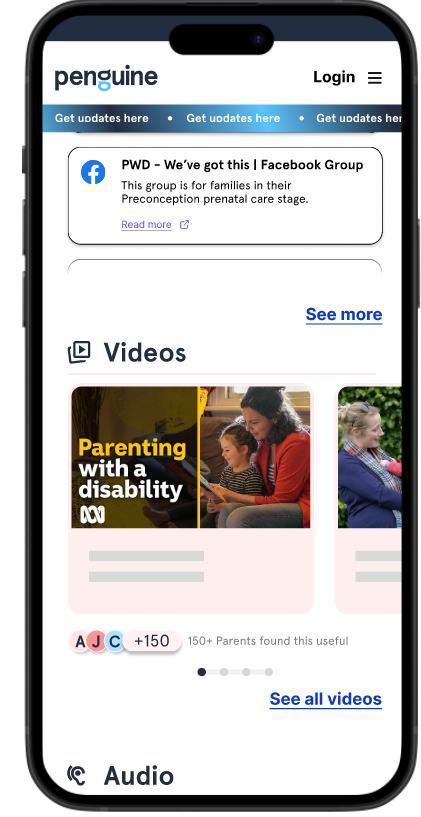

Feedback:
‘’General subjects that people are asking for likely um are going to be like super helpful for this’’
-Maria F.
Based on personalization and feedback mechanism
1.
Business model testing
Method:
Social media profile tied to a landing page and a sign up form.
Testing Question: Willingness to pay.
Target:
Parents with disabilities, partners of parents with disabilities.
3.
4.
2. accessibilit y test
feature prioritization
Method:
In person feature Workshop, Online meetings, google form.
Testing Question: Prioritize features based on their importance and frequency of use.
Target:
Parents with disabilities, partners of parents with disabilities, disability Advocates, accessibility experts.
User flow test
Method: Figma prototype testing, testing questions: ease of use, intuitiveness, testing for concerns and wow factors during the process
Target:
Parents with disabilities, partners of parents with disabilities, disability Advocates, accessibility experts.
Method:
Conduct an accessibility test and report on the figma prototype
Testing Questions:
Color contrast ratios, Spacing used, use of different formats, guided search filtering
Target:
Parents with disabilities, partners of parents with disabilities, disability Advocates, accessibility experts.
Last s ection next page
Stakeholder analysis
Our mission is to make information accessible to all, and accessibility is one of our core values. Conducting an accessibility test of our prototype was a key milestone of Penguine. Color contrast ratios, Spacing used, use of different formats, guided search filtering, were all tests that we conducted in every step of our user journey.
designing for motor disabilties
Implemented and tested
designing
Implemented and tested
designing for low vision
Implemented and tested
designing for screen readers
Implemented not tested

designing for Dyslexia
Implemented not tested
designing for autism spectrum
Implemented not tested
feature iterations
us of simpl colours
wri in plain en lish
We are a safe space for parents with disabilities.

consis n layou s
Mak bu ons d scrip iv
for
wri d scrip iv links and h adin s


Whats on your mind
build for k yboard us only ESC









follow a lin ar lo ical layou


designing for motor disabilties
Ma in lar e clic able actions
give form field spaces
let users request an interpreter for appointments (part of the roadmap feature iterations
designing for Deaf or hard of hearing
Write in plain en lish use subtitles or provide transcripts for videos

form field spaces ncreased tap area
desi nin with keyboard or speech only use


form field spaces
provide shortcuts

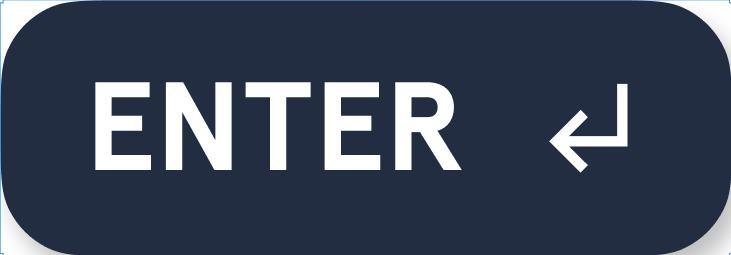











brea up content with sub headin s, ima es and videos

ma in ima es more descriptive

use good colo r contrast and readable font size

colour contrast ratio of colour combinations used in the webpage
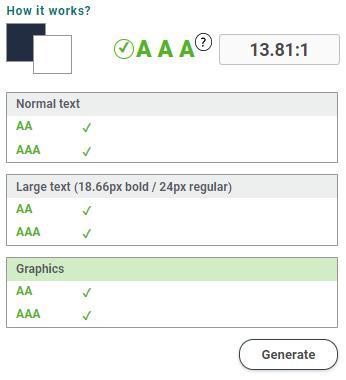
p t b ttons and notifications in context
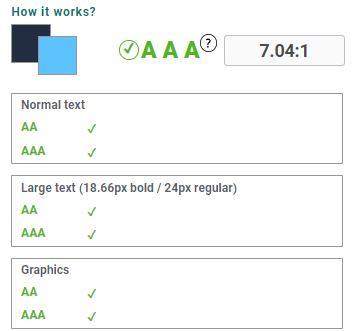



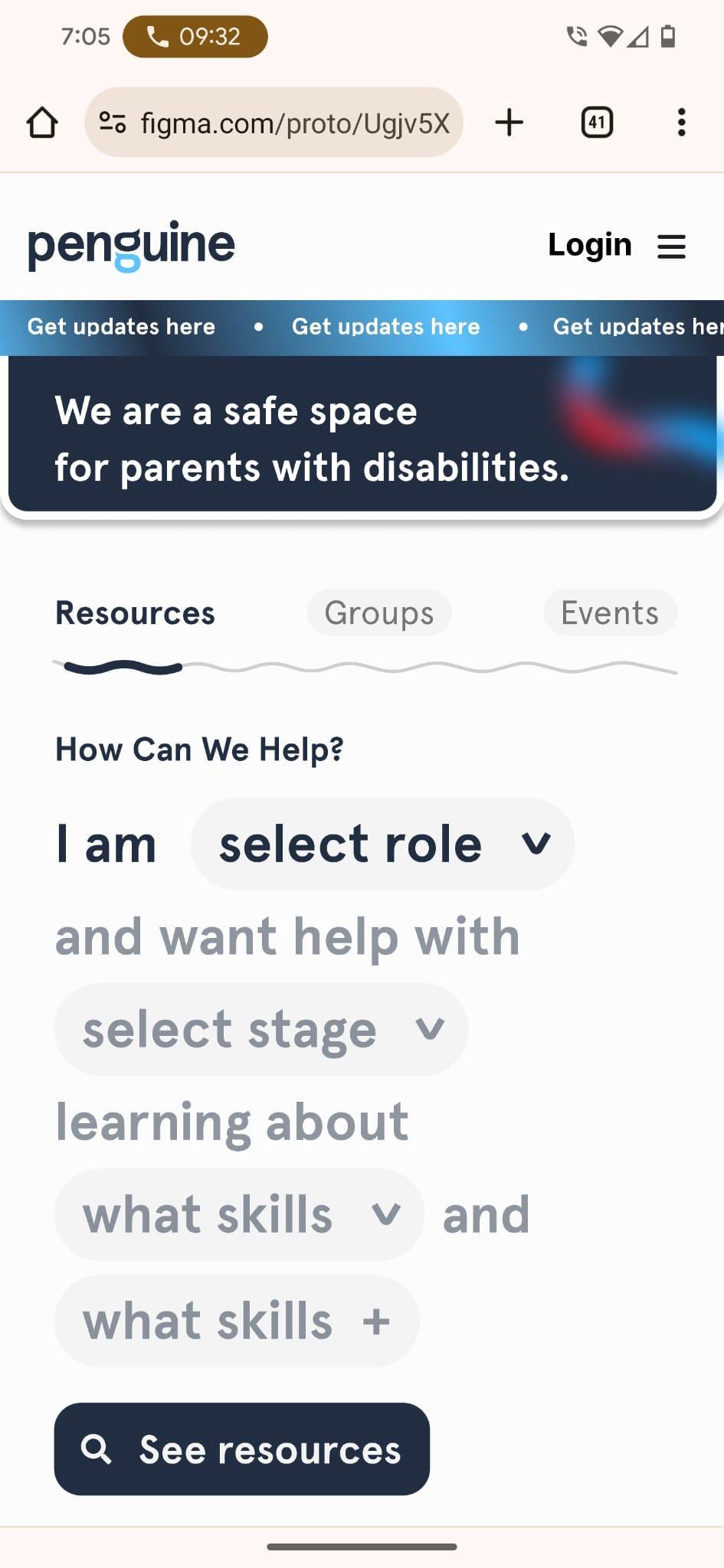
Largest Text size-32px
Smallest Text size-18px
usea a combination of colo rs, shapes and text



align text to the left and keep a consistent layout


let users change the contrast between background and text

Advantages of having a dark mode
beneficial for users with low vision and light sensitivit
Inverted text is easier to read for longer periods of time and is less likely to cause eye strain or fatigue
The appropriate level of contrast for text to be accessible is 4.5:1 for normal text, and for large text (18 point and above or 14 point bold and above), the ratio is 3:1.

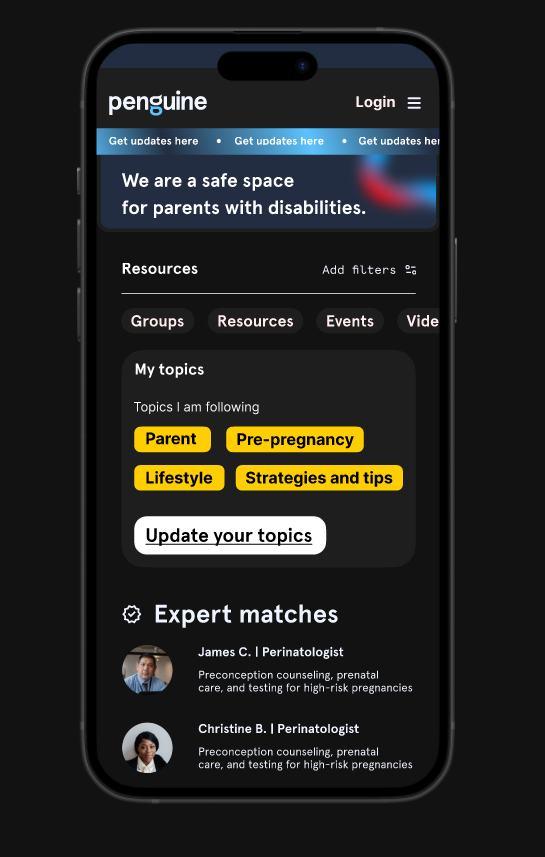
Could not have done it without them.
Rhea Alexander, Sareeta Amrute, SDM Class of 2024,
Maria Fernanda La Rotta, Marjorie Aunos, Matt Bowen, Aaron Baker, Dani Izzy,
Dan Pitaluga, Nicholas Steenhout, Whitney Weldon,
Connect with us


Camilo Lizarralde
E-mail: lizac194@newschool.edu
Phone: (929) 867 9743

Shreyans Baid
E-mail: shreyansbaid@newschool.edu
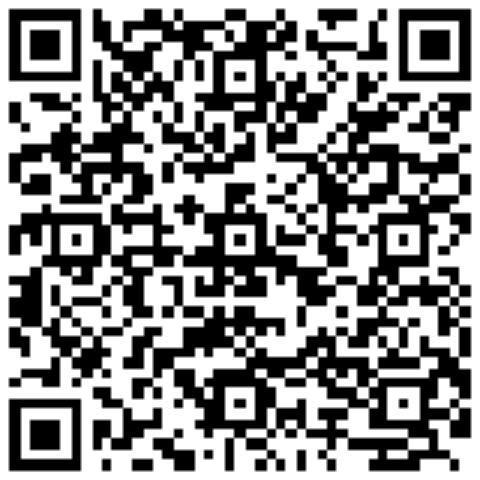

Phone: (551) 689 7024